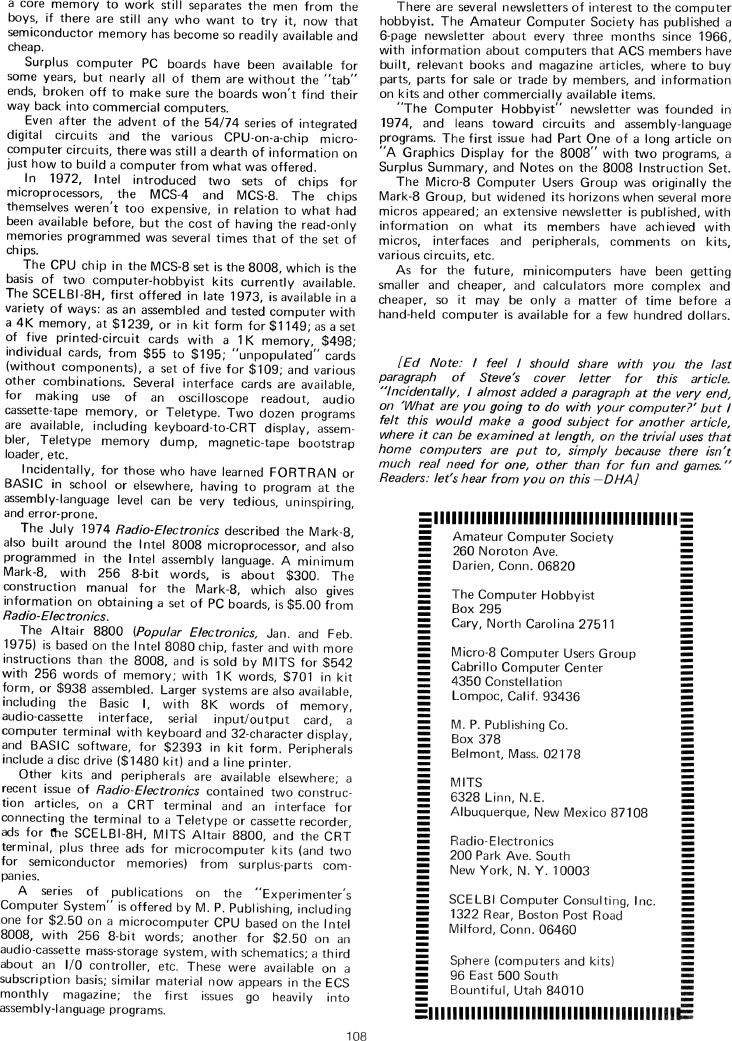The Best of Creative Computing Volume 1 (published 1976)
Building a Computer of Your Own (MCS-4, MCS-8, Mark-8, MITS Altair 8800)

a core memory to work still separates the men from the boys, if there are still
any who want to try it, now that semiconductor memory has become so readily
available and cheap.
Surplus computer PC boards have been available for some years, but nearly all of
them are without the "tab" ends, broken off to make sure the boards won't find
their way back into commercial computers.
Even after the advent of the 54/74 series of integrated digital circuits and the
various CPU-on-a-chip microcomputer circuits, there was still a dearth of
information on just how to build a computer from what was offered.
ln 1972, Intel introduced two sets of chips for microprocessors, the MCS-4 and
MCS-8. The chips themselves weren't too expensive, in relation to what had been
available before, but the cost of having the read-only memories programmed was
several times that of the set of chips.
The CPU chip in the MCS-8 set is the 8008, which is the basis of two
computer-hobbyist kits currently available. The SCELBI-8H, first offered in late
1973, is available in a variety of ways: as an assembled and tested computer
with a 4K memory, at $1239, or in kit form for $1149; as a set of five
printed-circuit cards with a 1K memory, $498; individual cards, from $55 to
$195; "unpopulated" cards (without components), a set of five for $109; and
various other combinations. Several interface cards are available, for making
use of an oscilloscope readout, audio cassette-tape memory, or Teletype. Two
dozen programs are available, including keyboard-to-CRT display, assembler,
Teletype memory dump, magnetic-tape bootstrap loader, etc.
Incidentally, for those who have learned FORTRAN or BASIC in school or
elsewhere, having to program at the assembly-language level can be very tedious,
uninspiring, and error-prone.
The July 1974 Radio-Electronics described the Mark-8, also built around the
Intel 8008 microprocessor, and also programmed in the Intel assembly language. A
minimum Mark-8, with 256 8-bit words, is about $300. The construction manual for
the Mark-8, which also gives information on obtaining a set of PC boards, is
$5.00 from Radio-Electronics.
The Altair 8800 (Popular Electronics, Jan. and Feb. 1975) is based on the lntel
8080 chip, faster and with more instructions than the 8008, and is sold by MITS
for $542 with 256 words of memory; with 1K words, $701 in kit form, or $938
assembled. Larger systems are also available, including the Basic I, with 8K
words of memory, audio-cassette interface, serial input/output card, a computer
terminal with keyboard and 32-character display, and BASIC software, for $2393
in kit form. Peripherals include a disc drive ($1480 kit) and a line printer.
Other kits and peripherals are available elsewhere; a recent issue of
Radio-Electronics contained two construction articles, on a CRT terminal and an
interface for connecting the terminal to a Teletype or cassette recorder, ads
for the SCELBI-8H, MITS Altair 8800, and the CRT terminal, plus three ads for
microcomputer kits (and two for semiconductor memories) from surplus-parts
companies.
A series of publications on the "Experimenter's Computer System" is offered by
M. P. Publishing, including one for $2.50 on a microcomputer CPU based on the
lntel 8008, with 256 8-bit words; another for $2.50 on an audio-cassette
mass-storage system, with schematics; a third about an I/0 controller, etc.
These were available on a subscription basis; similar material now appears in
the ECS monthly magazine; the first issues go eavily into assembly-language
programs.
There are several newsletters of interest to the computer hobbyist. The Amateur
Computer Society has published a 6-page newsletter about every three months
since 1966, with information about computers that ACS members have built,
relevant books and magazine articles, where to buy parts, parts for sale or
trade by members, and information on kits and other commercially available
items.
"The Computer Hobbyist" newsletter was founded in 1974, and leans toward
circuits and assembly-language programs. The first issue had Part One of a long
article on "A Graphics Display for the 8008" with two programs, a Surplus
Summary, and Notes on the 8008 Instruction Set.
The Micro-8 Computer Users Group was originally the Mark-8 Group, but widened
its horizons when several more micros appeared; an extensive newsletter is
published, with information on what its members have achieved with micros,
interfaces and peripherals, comments on kits, various circuits, etc.
As for the future, minicomputers have been getting smaller and cheaper, and
calculators more complex and cheaper, so it may be only a matter of time before
a hand-held computer is available for a few hundred dollars.
[Ed Note: I feel I should share with you the last paragraph of Steve's cover
letter for this article. "Incidentally, I almost added a paragraph at the very
end, on 'What are you going to do with your computer?' but I felt this would
make a good subject for another article, where it can be examined at length, on
the trivial uses that home computers are put to, simply because there isn't much
real need for one, other than for fun and games."
Readers: Let's hear from you on this -DHA]
[image]Amateur Computer Society
260 Noroton Ave.
Darien, Conn. 06820
The Computer Hobbyist
Box 295
Cary, North Carolina 27511
Micro-8 Computer Users Group
Cabrillo Computer Center
4350 Constellation
Lompoc, Calif. 93436
M. P. Publishing Co.
Box 378
Belmont, Mass, 02178
MITS
6328 Linn, N.E.
Albuquerque, New Mexico 87108
Radio-Electronics
200 Park Ave. South
New York, N. Y. 10003
SCELBI Computer Consulting, Inc.
1322 Rear, Boston Post Road
Milford, Conn. 06460
Sphere (computers and kits)
96 East 500 South
Bountiful, Utah 84010
108


